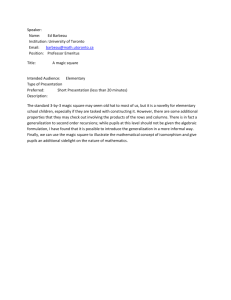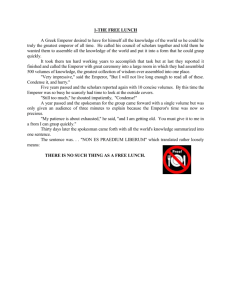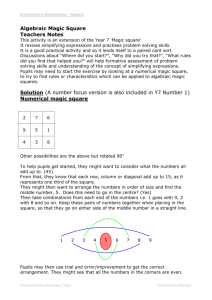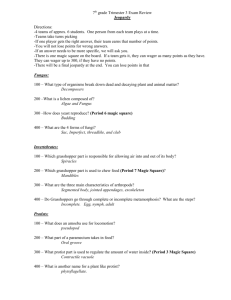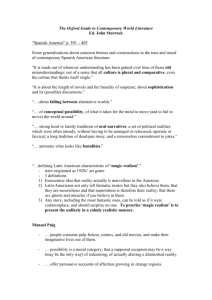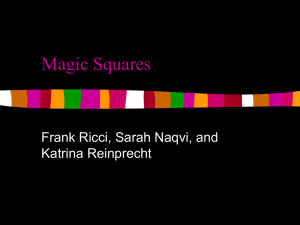Magic squares
advertisement
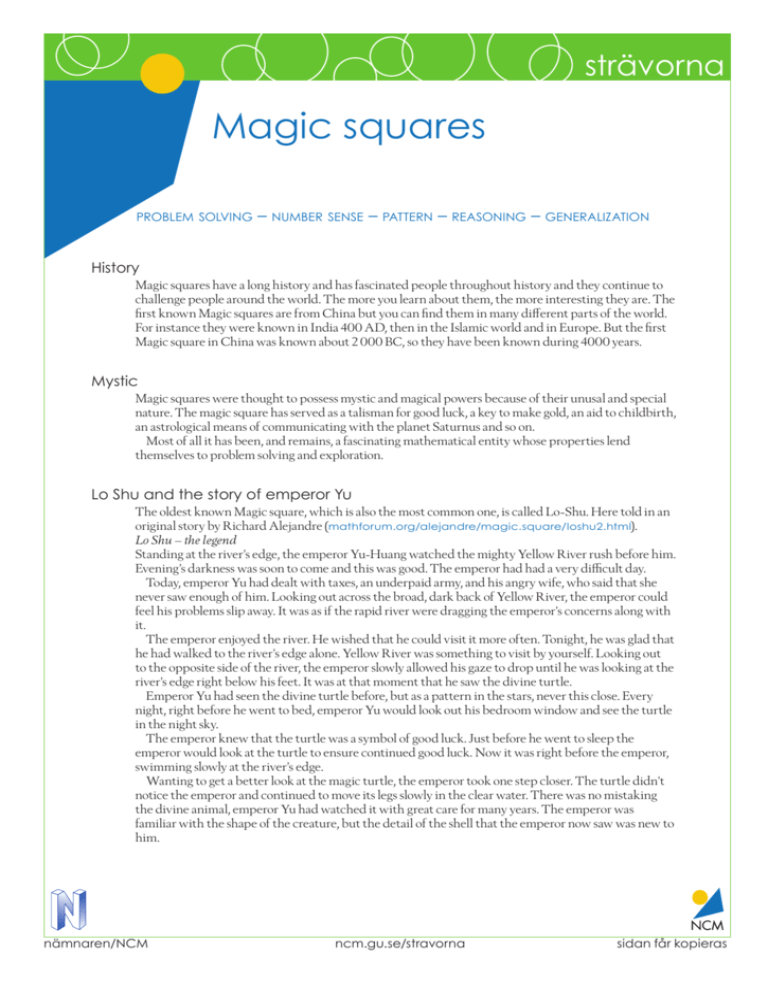
strävorna Magic squares problem solving – number sense – pattern – reasoning – generalization History Magic squares have a long history and has fascinated people throughout history and they continue to challenge people around the world. The more you learn about them, the more interesting they are. The first known Magic squares are from China but you can find them in many different parts of the world. For instance they were known in India 400 AD, then in the Islamic world and in Europe. But the first Magic square in China was known about 2 000 BC, so they have been known during 4000 years. Mystic Magic squares were thought to possess mystic and magical powers because of their unusal and special nature. The magic square has served as a talisman for good luck, a key to make gold, an aid to childbirth, an astrological means of communicating with the planet Saturnus and so on. Most of all it has been, and remains, a fascinating mathematical entity whose properties lend themselves to problem solving and exploration. Lo Shu and the story of emperor Yu The oldest known Magic square, which is also the most common one, is called Lo-Shu. Here told in an original story by Richard Alejandre (mathforum.org/alejandre/magic.square/loshu2.html). Lo Shu – the legend Standing at the river’s edge, the emperor Yu-Huang watched the mighty Yellow River rush before him. Evening’s darkness was soon to come and this was good. The emperor had had a very difficult day. Today, emperor Yu had dealt with taxes, an underpaid army, and his angry wife, who said that she never saw enough of him. Looking out across the broad, dark back of Yellow River, the emperor could feel his problems slip away. It was as if the rapid river were dragging the emperor’s concerns along with it. The emperor enjoyed the river. He wished that he could visit it more often. Tonight, he was glad that he had walked to the river’s edge alone. Yellow River was something to visit by yourself. Looking out to the opposite side of the river, the emperor slowly allowed his gaze to drop until he was looking at the river’s edge right below his feet. It was at that moment that he saw the divine turtle. Emperor Yu had seen the divine turtle before, but as a pattern in the stars, never this close. Every night, right before he went to bed, emperor Yu would look out his bedroom window and see the turtle in the night sky. The emperor knew that the turtle was a symbol of good luck. Just before he went to sleep the emperor would look at the turtle to ensure continued good luck. Now it was right before the emperor, swimming slowly at the river’s edge. Wanting to get a better look at the magic turtle, the emperor took one step closer. The turtle didn’t notice the emperor and continued to move its legs slowly in the clear water. There was no mistaking the divine animal, emperor Yu had watched it with great care for many years. The emperor was familiar with the shape of the creature, but the detail of the shell that the emperor now saw was new to him. nämnaren/NCM ncm.gu.se/stravorna sidan får kopieras strävorna A turtle’s hard back is half of the tough house that protects its body from enemies. The roof of this house looks like puzzle pieces glued together to form two circles around a rectangle. Emperor Yu looked long at these shapes on the turtle’s back and noticed a pattern of dots etched on them. He saw the dots: Starting next to the turtle’s right leg was a square formed by four linked dots. Traveling around the shell as the hands of a clock travel, the emperor came next to nine dots in a row. At the five o’clock position of a clock face there were two dots. At the bottom or six o’clock position was a row of seven linked dots. Next came a rectangle etched by six dots, and then a solitary dot at the nine o’clock spot. A long rectangle of eight dots followed, and at the top was a short line of three dots. In the center of all these dots was the intersection of two lines sharing five dots (picture from mathforum.org). What did this all mean, the emperor wondered. Was the divine turtle giving a signal? As the river became dark, the emperor lost sight of the turtle and started for home. Walking slowly, the emperor thought about the different numbers and their positions one to another. Emperor Yu added up the numbers many different ways. What did the magic sum have to do with him? Was it years of good luck? Or was it years to live? The questions came easily, but the answers were nowhere to be found. The emperor was troubled. He had come to the river’s edge to seek tranquillity, and instead had found doubt. The divine turtle had visited, but instead of bringing good luck he had left uncertainty. What was the emperor to do? In Sweden we have a legend which says that the Magic square with the numbers was a plan of China that told the emperor how he should solve the enormous trouble with the nine rivers in China which were flooded each year so the people died of hunger. The Emperor solved the problem and was honoured as a hero. Everyone in Chine became very happy with the help of the Magic square on the divine turtle. This Magic square became known as the Luoshu or the Lou River document. How to use it In a Magic square you are going to place the numbers between 1 to 9 in each cell of the square in such a way that the sum of every row, column and diagonal will be the same. You can only use each number once. The number of every row, column and diagonal is called the magic sum or the magic constant. Solutions In how many different ways can you solve a Magic square when you use each number 1–9? nämnaren/NCM ncm.gu.se/stravorna sidan får kopieras strävorna There are eight ways when reflections and rotations are allowed, but in fact it is just one solution and and its seven reflections and rotations. • Rotation solutions can be obtained by rotating a corner of the original square 90 degrees each time. • Reflection solutions can be obtained by pretending that you are holding a mirror to the original square and each of the rotation solutions. Three main properties • The order of a Magic square is defined by the number of rows or columns. An order four Magic square has four rows or columns. • Each row, column and diagonal of a Magic square totals the same number. This number is called the magic constant or magic sum. • Any two numbers in a row, column or diagonal that are equidistant from the center are complements to each other. Mathematical content There are a lot of mathematics in the Magic squares, they are interesting to work with in school and you can work with them at different levels. Magic square are common in pupils´ mathbooks. Normally the pupils use paper and pencils when they work with a Magic square and when they do not find the solution they use their rubber again and again and again … After a while the paper is grey and black after all the rubbing, perhaps the paper get ragged or torned. In this activity we do it in a different way, using bottle caps instead of paper and pencil. There are many ways to find the magic sum, here are some ... • Add all the numbers 1 + 2 + 3 … divide with 3 because you have three rows the magic sum is 15 • Add the first and the last number in the number sequence, in this case 1 + 9 then multiply with the numbers of terms and divide with 2 because you use them twice n (a1 +a2)/2 n = the numbers of terms a1 = the smallest term a2 = the biggest term But, it must be a number sequence 1, 2, 3; 23, 24, 25; 86, 87, 88 • Write down all the numbers 1+2+3+4+5+6+7+8+9 add the first and the last 1+9 =10 add the second and the second last 2+8 =10 and so on add them all and add the lonely 5 you get 45 divide with 3 15 nämnaren/NCM ncm.gu.se/stravorna sidan får kopieras strävorna • A generalized formula for the magic sum. If n is the order of the magic square the number of cells in a row = n, raised to the third power n3 33 = 3 · 3 · 3= 27 Add the number of cells in a row to the result n3 + n 27 + 3 = 30 divide the result by 2 n3 + n/2 30 / 2 =15 But, this formula only works if the numbers used in the square are consecutive numbers beginning with 1 and ending with n2. Different levels When you do this activity with your pupils you choose how difficult the activity will be, perhaps • you tell them from the beginning that the magic sum/sum in each row, column and diagonal is 15 • if they are a little bit older, they can try on their own in the beginning then you can ask just the pupils who are puzzled: Do you want a clue? Then you whisper: the sum is 15 and let the other pupils go on trying to find the sum on their own Do you want any more clue? 5 in the middle 9 can not be in the corner. You can use the same ”trick” if pupils want you to check their answer If number 5 is not in the middle, it is not correct If number 9 is in a corner, it is not correct and your pupils will be impressed, their teacher is very rapid in mental arithmetic. When some pupils are early finished, you can ask them: • Can you find any pattern in the solution of the Magic Square? • Can you find any additional solution? Perhaps they find all eight solutions. Follow-up You can highlight the mathematical content by asking your pupils: • Where are the even numbers? • Where are the odd numbers? • What do you discover if you look at the numbers at each side of the number in the middle? • What do you discover if you compare the number in the middle and the sum of the numbers on each row and column? Why? • Number 9 can not be in a corner. Why? • Number 5 must be in the middle. Why? • What was easy? • What was the most difficult to understand? • What can you learn from this activity? • What kind of math can you find in this activity? • Why do you think it is called Magic square? nämnaren/NCM ncm.gu.se/stravorna sidan får kopieras Magic squares Material Nine bottle caps with the numbers 1 to 9 written inside. Instructions Place the bottle caps on the grid, making the same sum of every row, column and diagonal. nämnaren/NCM ncm.gu.se/stravorna sidan får kopieras
